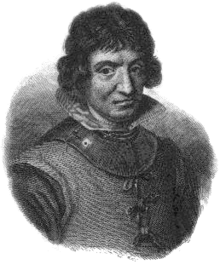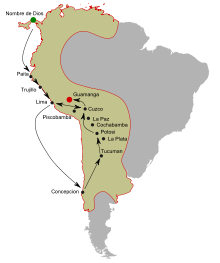- Catalina de Erauso
-
Catalina de Erauso, also known as La Monja Alférez (English, The Nun Lieutenant) (1592,[1] San Sebastián, Spain—1650, Cuetlaxtla, New Spain), was a semi-legendary personality of the Basque Country, Spain and Spanish America in the first half of the seventeenth century.
Contents
Life
Catalina de Erauso was daughter and sister of soldiers from the city of San Sebastián in Spain. Her father was Miguel de Erauso and her mother María Pérez de Gallárraga y Arce. She was expected to become a nun but abandoned the nunnery after a beating at the age of fifteen, just before she was to take her vows. She had not ever seen a street, having entered the convent at the age of four.
She dressed as a man, calling herself "Francisco de Loyola", and left on a long journey from San Sebastian to Valladolid. From there she visited Bilbao, where she signed up on a ship with the assistance of other Basques. She reached Spanish America and enlisted as a soldier in Chile under the name Alonso Díaz Ramírez de Guzmán. She served under several captains in the Arauco War, supposedly including her own brother, who never recognized her.
After one fight in which she killed a man and was wounded apparently fatally, she revealed her gender in a deathbed confession. She however survived after four months of convalescence and left for Guamanga.
To escape yet another incident, she confessed her sex to the bishop, Fray Agustín de Carvajal. Induced by him she entered a convent and her story spread across the ocean. In 1620, the archbishop of Lima called her. In 1624, she arrived in Spain, having changed ship after another fight.
She went to Rome and toured Italy, where she eventually achieved such a level of fame that she was granted a special dispensation by Pope Urban VIII to wear men's clothing.
Her portrait by Francesco Crescenzio is lost. Back in Spain, Francisco Pacheco (Velázquez's father-in-law) painted her in 1630.
She again left Spain in 1645, this time for New Spain in the fleet of Pedro de Ursua, where she became a mule driver on the road from Veracruz. In New Spain she used the name Antonio de Erauso.
She died in Cuetlaxtla, New Spain in 1650.
Appearance
Pedro del Valle described her in a 1626 letter sent from Rome to Mario Schipano as fond of conversation, tall and strong with masculine looks and childlike breasts after the application of an Italian remedy. Her face is not ugly but worn by age, looking more like a eunuch than a woman.[citation needed]
She dressed as a Spanish man, with a sword, more as a soldier than a courtier.
In media
In 1625, Juan Pérez de Montalván's play Comedia famosa de la monja Alférez appeared, profiting from her fame. In that same year, a "True narration of the great feats..." was published in Seville, followed by a "Second narration..." and a "Last and third narration..." from Mexico.[citation needed]
An alleged autobiography from 1626 exists, the earliest manuscript of which dates from 1794 and which was first published in 1829.[2]
Her life was also the theme of various novels and of a study by Dr. Nicolás León.[citation needed]
In 1943, Emilio Gómez Muriel made a film of her life, with María Félix playing Erauso. A further movie, starring Esperanza Roy, was released in Spain in 1987.[citation needed]
The character of Catalina Erantzo in the video game Uncharted Waters: New Horizons was named for and somewhat influenced by her, being a female Spanish commodore.[citation needed]
Footnotes
- ^ 1592 according to the record of her baptism; 1585, according to her supposed autobiography. See Stepto 1996, p. xxvi.
- ^ For the book's textual history, see the "Translators' Note" to Erauso 1996.
References
- Erauso, Catalina de (1996), Lieutenant Nun: Memoir of a Basque Transvestite in the New World, Boston: Beacon, ISBN 0807070726. Trans. Michele Stepto and Gabriel Stepto.
- Stepto, Michele (1996), "Introduction", in Erauso, Catalina de, Lieutenant Nun: Memoir of a Basque Transvestite in the New World, Boston: Beacon, pp. xxv-xliv, ISBN 0807070726. Trans. Michele Stepto and Gabriel Stepto.
Further reading
- (Spanish) "Alférez, La Monja," Enciclopedia de México, v. 1. Mexico City, 1988.
- (Spanish) Erauso y Pérez de Galarraga, Catalina de at the Auñamendi Encyclopedia.
External links
- Short biography, with a bibliography
- (Spanish) Her autobiography scanned (1838)
- (Spanish) Her autobiography transcribed
- Petition of Catalina de Erauso to the Spanish Crown, 1625
- Catalina de Erauso article at WOA-TV
- Link to the movie at IMDb
Categories:- 1592 births
- 1650 deaths
- People of the Arauco War
- Basque explorers
- Basque people
- 17th-century Spanish people
- Colonial Chile
- Colonial Mexico
- Female wartime cross-dressers
- People from Gipuzkoa
- People from San Sebastián
- Women in 17th-century warfare
- LGBT military personnel
- LGBT people from Spain
Wikimedia Foundation. 2010.


